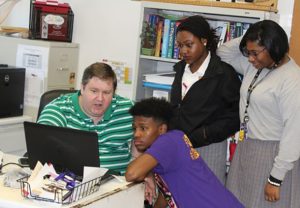Study Demonstrates High School Teaching Method for Oil Spill Science
– DECEMBER 10, 2019
University of New Orleans doctoral student Kendal Leftwich, who is a member of the LADC-GEMM research consortium investigating how Deepwater Horizon affected large marine mammals, created and implemented a year-long physics methodology to engage high school students in university research. The method helped students experience hands-on scientific research and being part of a research group, which are desirable skills for college graduates. The students worked with marine mammal acoustic data and took ownership of their group’s research and results. As the year progressed, the students began functioning nearly autonomously, demonstrating excellent capability for scientific research. The authors hope that their methodology and experiences will encourage other university researchers to begin a similar outreach program, which can help inspire students to pursue a college-level STEM field.
The researchers published their findings in The Physics Teacher: Introducing scholarly research to high school physics students.
Study author Kendal Leftwich, who also teaches high school physics at Warren Easton Charter High School in New Orleans, directed the project that included five high school students, who, surprisingly, were not aware that whales lived in the Gulf of Mexico. “We think it is important to foster and grow students’ interests in science and scientific research,” explained Leftwich. “All too often students are not introduced to scientific research until they are at a university, and often not until their third or fourth year.”
The project required that the students devote 2-5 hours per week analyzing marine mammal acoustic data, creating a lab book with PowerPoint slides detailing marine mammal clicks, and attending bi-weekly meetings. Periodically, university graduate students received the lab books and conducted more advanced acoustic signal processing such as determining whale lengths, tracking marine mammals, and generating population density estimates.
The high school students received a new task every other week related to the consortium’s oil spill research and analyzed data using mathematical methods and computer programs to identify marine mammal clicks and create time series graphs, spectrograms, and power spectral density plots. As the students became comfortable reading and interpreting the data, they suggested their own research goals, becoming self-directing. They also took turns as team leader, data and minutes recorder, and data analyst, naturally gravitating to one role or another over time and revealing preferences and strengths.
The authors noted that the students’ hands-on experiences are ones needed for the workplace and that students who lead and take responsibility for research tasks often experience a change in perspectives about their own education and career path. The team stated that employer reviews indicate that graduates with physics and engineering degrees benefit from having early involvement in interdisciplinary research activities that include working in teams, using specific computer programs, and speaking and writing skills.
The authors hope to continue their relationship with Warren Easton Charter High School and extend the program to other New Orleans schools, becoming a city-wide consortium. Their goal is to help students achieve scientific goals, present findings to local science faculty and graduate students, create science fair projects, and be better prepared for university-level research.
“We need more scientists and engineers to solve existing technical problems, such as understanding the impacts of events such as Deepwater Horizon,” said Leftwich. “Studies such as ours show that [high school] students can discover that they are interested in a science career. Some of the feedback from students suggest that [they offer] a great deal of unrealized potential for new ideas and new approaches to solving some of our current research problems. [Efforts like this] can elevate and encourage the developing minds of our society.”
This study’s data are publicly available through the Gulf of Mexico Research Initiative Information & Data Cooperative (GRIIDC) at DOI 10.7266/N7ZC80ZG and DOI 10.7266/N7JQ0ZF1.
The study authors are Kendal M. Leftwich, Juliette W. Ioup, and C. Gregory Seab.
By Nilde Maggie Dannreuther. Contact maggied@ngi.msstate.edu with questions or comments.
************
This research was made possible in part by a grant from the Gulf of Mexico Research Initiative (GoMRI) to the Littoral Acoustic Demonstration Center-Gulf Ecological Monitoring and Modeling (LADC-GEMM) consortium.
The Gulf of Mexico Research Initiative (GoMRI) is a 10-year independent research program established to study the effect, and the potential associated impact, of hydrocarbon releases on the environment and public health, as well as to develop improved spill mitigation, oil detection, characterization and remediation technologies. An independent and academic 20-member Research Board makes the funding and research direction decisions to ensure the intellectual quality, effectiveness and academic independence of the GoMRI research. All research data, findings and publications will be made publicly available. The program was established through a $500 million financial commitment from BP. For more information, visit https://gulfresearchinitiative.org/.
© Copyright 2010-2019 Gulf of Mexico Research Initiative (GoMRI) – All Rights Reserved. Redistribution is encouraged with acknowledgement to the Gulf of Mexico Research Initiative (GoMRI). Please credit images and/or videos as done in each article. Questions? Contact web-content editor Nilde “Maggie” Dannreuther, Northern Gulf Institute, Mississippi State University (maggied@ngi.msstate.edu).






